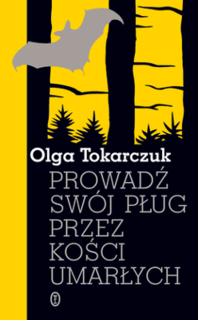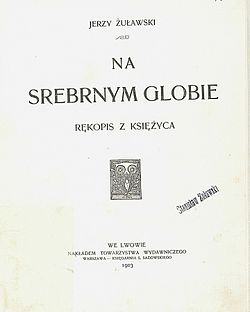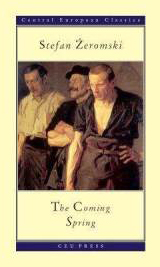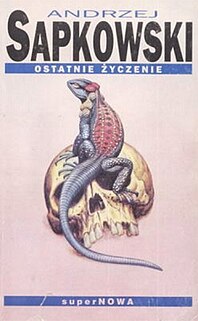 W
WAshes and Diamonds is a 1948 novel by the Polish writer Jerzy Andrzejewski. It was adapted into a film by the same title in 1958 by the Polish film director Andrzej Wajda. English translation, entitled Ashes and Diamonds, appeared in 1962. The story takes place during the last few days of World War II in Europe, and describes the political and moral dilemmas associated with the soon to be suppressed Anti-communist resistance in Poland (1944–1946). The protagonist Maciek is a soldier in the underground anti-communist Polish army assigned to kill the Communist Szczuka. The story follows Maciek's and other characters' actions in those ominous days.
 W
WThe Assisi Underground: The Priests Who Rescued Jews is a 1978 novel written by Alexander Ramati based on a true-life account, told by Father Rufino Niccacci, of events surrounding the Assisi Network, an effort to hide 300 Jews in the town of Assisi, Italy during World War II.
 W
WThe Career of Nicodemus Dyzma is a 1932 Polish bestselling political novel by Tadeusz Dołęga-Mostowicz. It was his first major literary success, with immediate material rewards, prompting Mostowicz to write and publish roughly two books per year. The book, very popular already in the interwar period, was made into a 1956 Polish film with Adolf Dymsza in the title role, then into a 1980 television miniseries starring Roman Wilhelmi, and into a 2002 comedy film starring Cezary Pazura.
 W
WThe Cottage outside the Village is a novel by the prolific Polish novelist Józef Ignacy Kraszewski, written in 1842. It was serialized in the monthly, Biblioteka Warszawska, over a two-year period in 1853-54. In 1854-55 it appeared in a three-volume book edition published by the St. Petersburg house of B.M. Wolff.
 W
WThe Deluge is a historical novel by the Polish author Henryk Sienkiewicz, published in 1886. It is the second volume of a three-volume series known to Poles as "The Trilogy," having been preceded by With Fire and Sword and followed by Fire in the Steppe. The novel tells a story of a fictional Polish-Lithuanian Commonwealth soldier and noble Andrzej Kmicic and shows a panorama of the Commonwealth during its historical period of the Deluge, which was a part of the Northern Wars.
 W
WThe Doll is the second of four acclaimed novels by the Polish writer Bolesław Prus. It was composed for periodical serialization in 1887–1889 and appeared in book form in 1890.
 W
WDrive Your Plow Over the Bones of the Dead is a 2009 mystery novel by Olga Tokarczuk. Originally published in Polish by Wydawnictwo Literackie, it was later translated to English by Antonia Lloyd-Jones and published in 2018 by the British independent publisher Fitzcarraldo Editions. The book received a wider release in 2019 when it was published in the United States by Riverhead Books on 13 August 2019. A portion of the English translation was originally published in literary magazine Granta in 2017.
 W
WFerdydurke is a novel by the Polish writer Witold Gombrowicz, published in 1937. It was his first and most controversial novel.
 W
WHis Master's Voice is a science fiction novel on the "message from space" theme written by Polish writer Stanisław Lem. It was first published in 1968 and translated into English by Michael Kandel in 1983. It is a densely philosophical first contact story about an effort by scientists to decode, translate and understand an extraterrestrial transmission. The novel critically approaches humanity's intelligence and intentions in deciphering and truly comprehending a message from outer space. It is considered to be one of the three best-known books by Lem, the other two being Solaris and The Cyberiad.
 W
WHospital of the Transfiguration is a book by Polish writer Stanisław Lem. It tells the story of a young doctor, Stefan Trzyniecki, who after graduation starts to work in a psychiatric hospital. The story takes place during the Nazi occupation of Poland in the Second World War.
 W
WIn Desert and Wilderness is a popular young adult novel by Polish author and Nobel Prize-winning novelist Henryk Sienkiewicz, written in 1911. It is the author's only novel written for children/teenagers. In Desert and Wilderness tells the story of two young friends, Staś Tarkowski and Nel Rawlison, kidnapped by rebels during Mahdi's rebellion in Sudan. It was adapted for film twice, in 1973 and in 2001.
 W
WKing Matt the First is a children's novel by Polish author, physician, and child pedagogue Janusz Korczak. In addition to telling the story of a young king's adventures, it describes many social reforms, particularly targeting children, some of which Korczak enacted in his own orphanage, and is a thinly veiled allegory of contemporary and historical events in Poland. The book has been described as being as popular in Poland as Peter Pan was in the English-speaking world. It was the first of Korczak's novels to be translated into English – several of his pedagogical works have been translated, and more recently his novel Kaytek the Wizard was also published in English.
 W
WThe Knights of the Cross or The Teutonic Knights is a 1900 historical novel written by the Polish Positivist writer and the 1905 Nobel laureate, Henryk Sienkiewicz. Its first English translation was published in the same year as the original.
 W
WTrylogia Księżycowa is a trilogy of science fiction novels by the Polish writer Jerzy Żuławski, written between 1901 and 1911. It has been translated into Russian, Czech, German and Hungarian, and has been reprinted several times in Poland. They are his best-known works.
 W
WThe Magellanic Cloud is a 1955 science fiction novel by Polish writer Stanisław Lem. Fragments of the novel were published earlier, in 1953 and 1954, in the magazine Przekrój. Some significant literary tropes featured in the novel include interstellar travel, "first contact", psychological fiction, a Communist utopia, and criticism of the capitalist militarism, which Lem himself characterized as an "extract of the times of Socialist realism".
 W
WThe Manuscript Found in Saragossa is a frame-tale novel written in French at the turn of 18th and 19th centuries by the Polish author Count Jan Potocki (1761–1815). It is narrated from the time of the Napoleonic Wars, and depicts events several decades earlier, during the reign of King Philip V.
 W
WThe New Woman is the third of four major novels by the Polish writer Bolesław Prus. It was composed, and appeared in newspaper serialization, in 1890-93, and dealt with societal questions involving feminism.
 W
WThe Painted Bird is a 1965 novel by Jerzy Kosiński that describes World War II as seen by a boy, considered a "Gypsy or Jewish stray," wandering about small villages scattered around an unspecified country in Central and Eastern Europe. The story was originally described by Kosiński as autobiographical, but upon its publication by Houghton Mifflin he announced that it was a purely fictional account.
 W
WThe Peasants is a novel written by Nobel Prize-winning Polish author Władysław Reymont in four parts between 1904 and 1909. He started writing it in 1897, but because of a railway accident and health problems, it took seven years to complete. The first parts of the story were published in the newspaper Tygodnik Ilustrowany.
 W
WPharaoh is the fourth and last major novel by the Polish writer Bolesław Prus (1847–1912). Composed over a year's time in 1894–95, serialized in 1895–96, and published in book form in 1897, it was the sole historical novel by an author who had earlier disapproved of historical novels on the ground that they inevitably distort history.
 W
WThe Promised Land is an 1899 novel by the Polish author and Nobel laureate, Władysław Reymont; first published in Warsaw. It is considered one of his most important works after The Peasants. The novel The Promised Land was originally published as installments in the industrial city of Łódź by the daily Kurier Codzienny from 1897 to 1898.
 W
WQuo Vadis: A Narrative of the Time of Nero, commonly known as Quo Vadis, is a historical novel written by Henryk Sienkiewicz in Polish.
 W
WSolaris is a 1961 philosophical science fiction novel by Polish writer Stanisław Lem. It follows a crew of scientists on a research station as they attempt to understand an extraterrestrial intelligence, which takes the form of a vast ocean on the titular alien planet. The novel is among Lem's best-known works.
 W
WThe Polish novel Przedwiośnie was written by the leading Polish neoromantic writer Stefan Żeromski, and first published in 1925, the year he died. The book has been translated and published in the U.S. as the Coming Spring in 2007.
 W
WKamienie na szaniec is a 1943 non-fiction novel by Polish writer Aleksander Kamiński. Published by the Polish underground press during the World War II occupation of Poland, the book describes the acts of sabotage and armed resistance carried out by the Polish underground scout movement, the Gray Ranks, of whom Kamiński was one of the instructors and leaders.
 W
WThe Witcher is a series of fantasy novels and short stories written by Polish author Andrzej Sapkowski. The series revolves around the titular "witcher", Geralt of Rivia. In Sapkowski's works, "witchers" are beast hunters who develop supernatural abilities at a young age to battle wild beasts and monsters. The books have been adapted into a film, two television series, a trilogy of video games, and a graphic novel series. The series of novels is known as the Witcher Saga. The short stories and novels have been translated into numerous languages, including Chinese, English, French, German, Italian, Russian, Lithuanian, Spanish and Ukrainian.
 W
WWith Fire and Sword is a historical novel by the Polish author Henryk Sienkiewicz, published in 1884. It is the first volume of a series known to Poles as The Trilogy, followed by The Deluge and Fire in the Steppe. The novel has been adapted as a film several times, most recently in 1999.